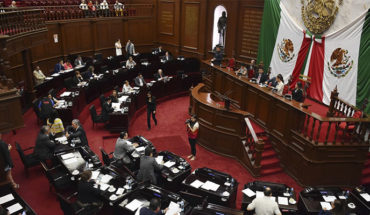Health, education, physical and mental development, as well as discrimination and violence are the landscape faced by children and adolescents who work, specifically in the Metro Collective Transportation System and the Central Abasto in Mexico City.
This, according to a report submitted by the Commission on Human Rights of Mexico City (CDHDF), which places the capital of the country as the second entity with the lowest rate of child labour (5.4%).
Read: Daily more than 3 children and adolescents die in Mexico from violence
The document, which cites several studies from 2015 and 2017, identifies on the Metro at least 1420 minors working in stations, of which 457 were between zero and five years old (105 children under three years – 68 were infants or infants – and 352 between three and five years), as well as 121 belonging to an indigenous group.
Educational lagging
The report states that the work or minors accompanying their parents are affected in their school performance, making them more likely to drop out of school.
“In its report on child labour in Mexico, the ILO (International Labour Organization) noted that children and adolescents in this situation have higher rates of school reprobration and lag, and lower educational attainment as a result of the tiredness and exhaustion with which they arrive in the classroom after long working hours, often in precarious and unsanitary situations,” the document said.
According to the agency’s report, the working child population has limited opportunities to remain in the formal education system due, among other topics, to the lack of expectations about the school, as well as the lack of support in the campuses for this group.
Power
The document states that some of the food practices observed in working children and adolescents in Mexico City pose a risk not only to their health, but also to their development.
Mainly because of the existence of “inadequate environments” that can affect their physical, cognitive and emotional development, such as noise pollution, garbage, work accidents and risky activities.
For example, those who work at the Abasto Central are more likely to develop bronchorespiratory diseases and gastrointestinal infections from the sudden temperature changes to which they are exposed.
In addition, they often resort to self-medication, because most of the people interviewed lack some form of social security.
The report turns out that many children and adolescents are in an environment where their work represents a significant household income.
“Child labour can increase household income to such an extent that researchers and specialists point out that it also significantly increases the likelihood of family survival. Moreover, the survival of the family depends on child labour, regardless of whether it is carried out in dangerous or non-hazardous conditions,” he said.
Find out: Federal government, no strategy to care for children under 5
Violence and discrimination
Working children also face discrimination, rejection and exclusion from society, as they “tend to see them as criminals,” the document states.
“An example of this is what is mentioned by children working at the Abasto Power Station, who reported having suffered Bullying and discrimination also because of their economic situation, which is one of the factors by which they do not attend school. This situation is particularly evident among the daughters and sons of garbage collectors, whom they often call cartoners,” he says.
These impacts, the study insists, have impacts on the enjoy and exercise of various rights, such as care.
The situation of insecurity and violence faced by this population will also change if they are women, members of an indigenous group or migrants.
Only among minors working in Metro and other public spaces, the study detected several risk situations such as the one that assaults them and removethe products they sell; confiscating your goods; assaults on Metro staff and other vendors and users; sexual harassment, even from cops, and the risk of being abused and abducted.
The CDHDF also identifies unmetdiated measures to be taken by various authorities, “so that child labour in all its forms is to be ended by 2025”.
It also calls for progress in complying with the Conventions on the Minimum Age for Admission to Employment and Worse Forms of Child Labour, which were ratified by Mexico in 2015 and 2000.
“In particular, work has to be done to re-register for the rights of working and accompanying children and adolescents, which implies a comprehensive look that also entails the restitution of rights of their families and the adults who are in charge of them.” Highlights.
Here you can see the full special report “The situation of child labour and adolescent work of age allowed in the Metro Collective Transport System, the Central Abasto and other public spaces of Mexico City”.
What we do in Animal Político requires professional journalists, teamwork, dialogue with readers and something very important: independence. You can help us keep going. Be part of the team.
Subscribe to Animal Politician, receive benefits and support free journalism.#YoSoyAnimal





